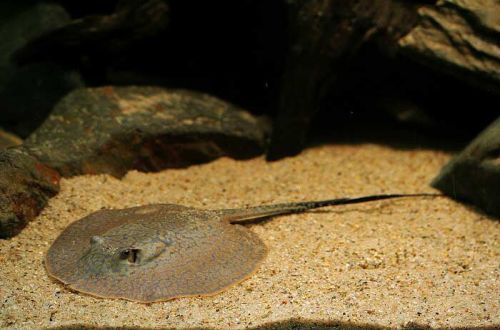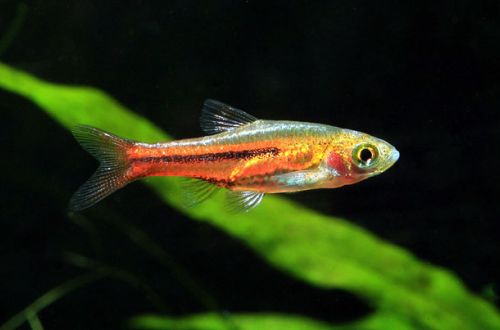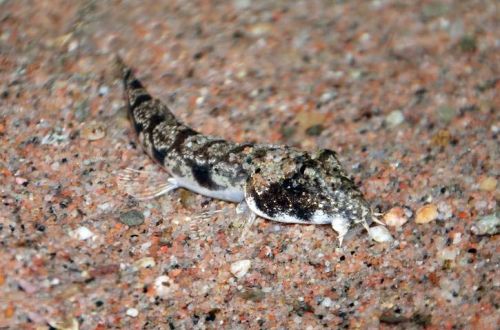
Mesh slope
The reticulated stingray, scientific name, Potamotrygon orbignyi, belongs to the family Potamotrygonidae (River stingrays). Previously, it had a different scientific identification and was called Potamotrygon reticulatus, which can now be considered a synonym.

Contents
Habitat
Native to South America. It is considered one of the most common types. The natural habitat extends over vast expanses of the Amazon and Orinoco river basins, as well as the river systems of Suriname, Guyana and French Guiana. Inhabits various biotopes, more often found in swampy areas of rivers, in shallow water with sandy and silty substrates.
Description
It has a disc-shaped body shape that is classic for stingrays. It reaches up to 35 cm in diameter. However, a long tail noticeably increases the overall size of the fish by two or more times. On a thin tail is a sharp but fragile spike, equipped with poisonous glands.
The body pattern consists of a grid pattern formed by several shades of brown.
Behavior and Compatibility
In their ecosystem, they are the main predators, for this reason they pose a direct threat to most small fish and freshwater shrimp. Despite their predatory lifestyle, the Reticulated Ray is not aggressive and peaceful towards species that are too large to be eaten.
As neighbors in the aquarium, you can consider some cichlids, for example, Geophagus, Cichlase Severum, and Pimelodus. In spacious tanks, joint keeping with American Aravans and Asian Tiger Bass is possible.
How to choose a mesh stingray?
These fish can often be found on sale. They are supplied either from South America or from nurseries in Europe and Asian countries. Regardless of the place of delivery and the duration of the journey, there is a high risk of acquiring sick and emaciated fish.
The fact is that because of its long tail, it often bends strongly in containers during transportation, and sometimes stays above water for a long time if the container for transportation is vertically oriented. Tail injuries are the main cause of disease.
Another problem is related to feeding. Unlike many related species, the Reticulated Ray has a smaller stomach volume relative to body weight, so it is necessary to feed food often, but in small portions. Accordingly, during transportation, the regularity of feeding is disturbed and the catfish arrive in an exhausted state. The most sensitive to the diet are young individuals, which are precisely the main object of trade.
Before buying, try to see the moment of feeding. Healthy individuals will not refuse food. Watch the fish, it should not show protrusions at the base of the caudal peduncle, there should be no depressions under the eyes – depressions. These are all clear signs of exhaustion. Visible damage, especially on the tail, is a sign of health problems.
Brief information:
- The volume of the aquarium – from 600 liters.
- Temperature – 24-26°C
- Value pH — 6.5–7.5
- Water hardness – soft (up to 10 dGH)
- Substrate type – soft sandy
- Lighting – subdued
- Brackish water – no
- Water movement – light or moderate
- Fish size – up to 35 cm (excluding tail)
- Nutrition – live or fresh food
- Temperament – peaceful towards fish of comparable size
- Content alone or in a group
- Life expectancy about 10 years
Maintenance and care, arrangement of the aquarium
If you managed to find a healthy stingray, then for one individual you will need an aquarium with a size of 600 liters or more, and the bottom area in this case will be more important than the height of the tank.
Not picky about design, the main condition is the presence of a large free space at the bottom. The focus is on the substrate. The use of river sand and fine gravel soil is recommended. It is acceptable to place several large snags, smooth stones and boulders. When choosing a decor, you should make sure that it is heavy enough that the ramp will not be able to move it.
Due to the need to dig into the ground, the need for plants is questioned. Most rooting species are likely to be uprooted. Alternatively, you can use plants that can grow on the surface of driftwood and stones, such as anubias, most aquatic ferns and mosses.
Filtration is one of the most important aspects of long term keeping. For bottom species, which are also predators, it is necessary to purchase efficient filtration systems consisting of one or more external filters. When choosing, preference should be given to models with a built-in heater and aerator to minimize the presence of equipment inside the aquarium.
High-quality filtration is considered to be one in which the device is able to pump through itself in one hour a volume of water equal to four volumes of the aquarium.
Water quality also depends on the regularity of maintenance. Half of the water in the tank should be replaced weekly, combined with the removal of organic waste (feed leftovers, excrement, etc.).
Food
The basis of the diet are small fish, freshwater shrimp and large invertebrates such as worms. Juveniles can take bloodworms, tubifex, brine shrimp, etc. Dry food is not used, only live or fresh products.
Food should be available in the aquarium at all times in small quantities.
Breeding / breeding
The reticulated stingray is a viviparous species of fish in which fry develop in the body of the mother and are born fully formed. This type of pregnancy lasts for several months. In one season, only 1-8 fry may appear.
It is noted that in aquariums the period of gestation of juveniles is less than in the wild.
Pisces are picky about choosing a partner. It is not enough to house two stingrays together and expect offspring from them. In the artificial environment of aquariums, the following strategy is used. They acquire a group of young fish, which, as they grow older, determine themselves with a suitable partner. However, this takes several years, which is not acceptable for the average aquarist. Thus, breeding stingrays is hardly carried out at home.





